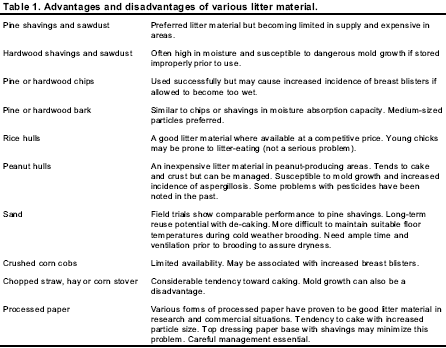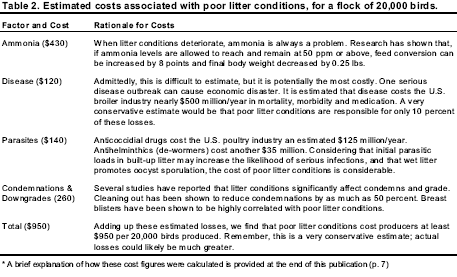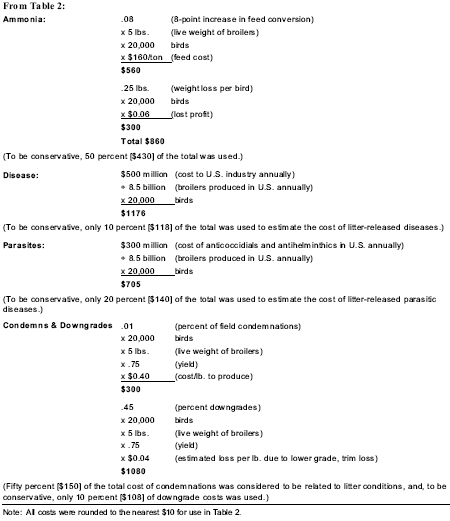



Litter Quality and Broiler Performance
By Casey W. Ritz, Brian D. Fairchild, and Michael P. Lacy Extension Poultry Scientists, University of Georgia - Quality of chicks, feed and water are all of great concern to broiler producers; but quality of litter in broiler houses is seldom given sufficient emphasis.This is unfortunate because birds are in continuous contact with litter. Litter conditions significantly influence broiler performance and, ultimately, the profits of growers and integrators. Litter is defined as the combination of bedding material, excreta, feathers, wasted feed and wasted water.
Sources of Bedding Material
Bedding material serves a number of important functions. For example, it:
absorbs excess moisture from the droppings and drinkers and promotes drying by increasing the surface area of the house floor.
dilutes fecal material, thus reducing contact between birds and manure.
insulates chicks from the cooling effects of the ground and provides a protective cushion between the birds and the floor.
An effective bedding material must be absorbent,
lightweight, inexpensive and non-toxic. Ideal materials
will have high moisture absorption and release
qualities to minimize litter caking. In addition, a
bedding material must be compatible as a fertilizer
or soil amendment after it has served its purpose in
the broiler house.
Many products have been used as bedding. The
quality and quantity of bedding materials can vary
greatly from one region to another. Table 1 (page 2)
lists various materials that have been tried with at
least some degree of success and briefly discusses
the advantages and disadvantages of particular litter
sources. Periodically by-products of other industries
have received interest as poultry bedding material.
Efforts to use these materials are primarily driven by
local recycling efforts and new market development.
Pine shavings and coarse pine sawdust are currently
the most popular bedding materials in Georgia; however,
these two types of material are becoming more
difficult to obtain with increasing frequency of periodic
shortages and escalating costs. When supply
and pricing become limiting factors, appropriate
substitutions need to be considered.
Use caution when considering alternative bedding
sources. Materials need to be evaluated based on
their performance potential, downgrading potential,
and potential for residues. The possibility of residues
is the most serious consideration, whether it be
compositional or accidental. If a chemical is in the
bedding material, it has the possibility of ending up
as a residue in broiler tissues.
Litter Quality and Performance
Broilers do not perform to their genetic potential
in a poor environment. The quality of the in-house
environment is highly dependent upon litter quality.
The litter environment is ideal for bacterial proliferation
and ammonia production. The two factors that
influence litter conditions most are manure and
moisture. The manure portion is largely out of a
grower’s control; however, growers can and must
control litter moisture.
Excess moisture in the litter increases the incidence
of breast blisters, skin burns, scabby areas,
bruising, condemnations and downgrades. The
wetter the litter, the more likely it will promote the
proliferation of pathogenic bacteria and molds. Wet
litter is also the primary cause of ammonia emissions,
one of the most serious performance and environmental
factors affecting broiler production today.
Controlling litter moisture is the most important step
in avoiding ammonia problems.
Many producers underestimate the detrimental
effects of ammonia. The human nose is able to detect
ammonia levels near 15 parts per million (ppm) but
will lose even this level of sensitivity with long-term
exposure. Ammonia concentrations of 50 to 110 ppm
can cause the human eye to burn and tear and induce
possible health risks to farm workers. EPA has set
human exposure standards that should not exceed 25
ppm per 8 hours or 35ppm per 15 minutes of
exposure. Chickens are also sensitive to ammonia.
Prolonged exposure to high levels (50 to 100 ppm)
can result in keratoconjunctivitis (blindness). Obviously,
when ammonia levels are high enough to
blind birds, production is seriously affected; however,
ammonia levels of just 25 ppm have been
found to depress growth and increase feed conversion
in broilers. In addition, a greater incidence of
airsacculitis, viral infections and condemnations
have been linked to ammonia levels at this concentration.
Ammonia volatilization from poultry litter
can also cause air pollution and lowered fertilizer
value of litter due to nitrogen loss.
Litter that is too dry and dusty can also lead to
problems such as dehydration of new chicks, respiratory
disease and increased condemnations. Ideally,
litter moisture should be maintained between 20 to
25 percent. A good rule of thumb in estimating litter
moisture content is to squeeze a handful of litter. If it
adheres tightly and remains in a ball, it is too wet. If
it adheres slightly, it has the proper moisture content.
If it will not adhere at all, it may be too dry.

As time passes, used litter can become seeded with pathogens that affect bird performance. High humidity, warm temperatures and high pH favor the proliferation of pathogens in the litter. Avian influenza, laryngotracheitis, gangrenous dermatitis, gumboro, reovirus, bronchitis and botulism are several of the more serious viral and bacterial diseases known to spread easily in contaminated litter. In addition, fungi that produce mycoses or mycotoxicoses have been isolated in broiler litter, and there is some evidence that these may cause increased mortality when flocks are reared on reused litter. Parasites, such as round worms, tapeworms and coccidia, are also a potential problem in reused litter. Wet litter further aggravates coccidiosis by providing the proper environment for oocysts to sporulate, thereby increasing challenge levels to which birds are exposed.
Management Practices to Improve Litter Quality
Many factors affect litter moisture. For instance,
if new litter is not stored properly and becomes damp
before it is spread in the broiler house, wet litter
problems would likely be unavoidable. Nutrition also
influences litter quality. Certain dietary ingredients
(especially salt), when fed in excess, cause broilers
to consume and excrete large amounts of water and
result in wet litter conditions. Some drugs also
stimulate excess water consumption and excretion.
Environmental conditions such as wet and humid
weather, condensation or very cold temperatures can
cause wet litter if the broiler house ventilation system
is not able to eliminate moisture effectively.
Drinker lines, foggers and evaporative cooling pads,
if not managed and maintained carefully, can contribute
greatly to wet litter problems.
Here are some key points to consider concerning
litter management:
Proper house preparation to release ammonia trapped in the litter is necessary to minimize ammonia release from the litter during brooding. Heating and ventilating the house 24-48 hours prior to chick placement will help to accomplish this.
It may be necessary to increase minimum ventilation during the first few weeks of growout if ammonia levels become too high. Begin with at least 1 minute out of 5 on your timer and decrease the ratio as needed.
Use circulation fans to move air within the house. The fans help litter dry by moving warm air (which can hold more moisture) off the ceiling and down to the floor.
In negative pressure power-ventilated houses, use air inlets to bring fresh air into the house. When fans are on, static pressure should be maintained at .05 to .10 inches of water, so air velocity through the inlets stays within the range of 600 to 1,200 feet per minute. This keeps cold air from dropping to the floor as it enters the house and promotes good air mixing.
Do not be afraid to add heat to the house to facilitate moisture removal. As air is warmed, its ability to hold moisture increases. The combination of heating and ventilating will remove considerable moisture from the house.
Check and manage watering systems to prevent leaks that will increase litter moisture. Adjust drinker height and water pressure as birds grow to avoid excessive water wastage into the litter.
If leaks or spills occur and wet spots develop, the affected litter should be removed from the house promptly and replaced with clean, dry bedding.
Remove cake with a housekeeping machine between flocks (rototilling is not recommended). Cake removal gets excessive moisture and manure out of the house, which, if left in the house, can contribute to elevated ammonia release from the litter in the ensuing flock. In most cases, these de-caking machines are more expensive than one grower can afford; however, several growers could share the equipment and reduce costs to a reasonable level. Take extreme care to completely disinfect such equipment before moving it from farm to farm.
Make sure no moisture is getting in from the outside. Check grading and drainage around the building to ensure that storm water is being diverted away and not causing a seepage issue under the pad.
Built-Up Litter Management
As a result of the availability and expense of pine
shavings and sawdust, and the difficulty of handling
and disposing of used litter, many poultry companies
and broiler producers have adopted the practice of
reusing litter for one, two or even more years of
production. This practice has become a standard in
the industry.
De-caking the house of crusted litter, preheating
and ventilating the house prior to each flock is necessary
to help purge the house of ammonia before
chick placement. Field experience shows that good
performance can be achieved by leaving the litter in
the house through several flocks and top-dressing the
old litter with a light layer of new litter between
flocks. This good performance may be facilitated
when the old litter serves as a reservoir for “good
bacteria” that acts by competitive exclusion to suppress
pathogens. Additionally, old litter typically
keeps the floors warmer during brooding.
Some growers do not top-dress between flocks
and have found birds do as well on used litter as
when top-dressed. Available machines can rework
the litter, pick up the cake, stir the litter pack, and
apply top-dress bedding. Annual savings estimates
from use of a housekeeping machine range from
$700 to $2500 per house in litter and cleanout costs.
The practice of growing broilers on built-up litter
provides considerable management challenges. The
potential for problems with ammonia, disease and
condemnations increases each time another flock is
grown on the same litter and intensifies the challenge
of maintaining optimal in-house environment. Controlling
darkling beetles can also be a challenge in
built-up litter houses.
Controlling litter moisture and ammonia emission
are primary areas of concern with built-up litter. The
use of nipple drinker systems, however, has made the
reuse of litter possible by reducing the moisture
content of the litter. The use of litter amendments,
coupled with moisture control have made the reuse
of litter in poultry houses a common practice.
Litter Amendments
As the practice of growing birds on built-up litter
has increased, considerable effort has been made
toward controlling the level of ammonia generated
within the poultry house. Numerous chemical and
biological litter amendments have been developed to
aid in addressing ammonia production from built-up
litter. The main premise of these products is the suppression
of ammonia volatilization from the litter.
Use of these products has become a common practice
to enhance quality of litter, both in the house and
as a plant fertilizer.
These treatment products fall into three categories:
1) acidifying agents that lower litter pH and
thereby inhibit the bacteria that transforms manure
nitrogen into ammonia, 2) clay-based products that
absorb odors and reduce ammonia release by absorbing
moisture, and 3) products that act by inhibiting
microbial growth and enzyme production through
competitive exclusion and enzyme inhibition. Litter
accumulation, litter moisture, bird type, brooding
temperature program and disease challenge are
among a number of variables that influence selection
of treatment, efficacy and return on investment.
Currently, the most effective products seem to be
those that react chemically to lower the pH of the
litter. The low pH creates an unfavorable environment
for most bacteria, including those responsible
for ammonia volatilization. Take care to ensure a
sufficient and timely application, adequate moisture
for activation, and appropriate ventilation. Failure to
meet these standards will lead to ineffectual treatment
and possible bird and human health safety
issues.
While the use of litter treatments has been effective
to a degree in controlling ammonia, their overall
use has met with varying levels of success. Most of
the chemical treatment products are only effective
less than three weeks during brooding and may have
limited long term impact on ammonia concentrations,
especially during later stages of production.
High litter moisture can reduce the effective life
of the products even more. Applying the product
over the equipment can leave a portion of the litter
untreated and can damage equipment over time. It is
extremely important to emphasize that litter treatments
are not a substitution for good ventilation.
Some producers mistakenly believe that the use of
litter treatments can reduce minimum ventilation
levels. Providing inadequate minimum ventilation
can potentially lead to more ammonia volatilization
with the amendments than without their use. Proper
house preparation, amendment application and litter
management are essential factors that need to be met
to maximize the effectiveness of litter treatment
products.
The potential benefits of litter treatment products
will continue to expand beyond improving bird
performance. Litter amendments are increasingly
viewed as products that can also address environmental
related concerns such as enhancing the
composition of litter for end-user markets, limiting
the emissions of ammonia and odor from poultry
houses, and reducing water-soluble phosphorus
concentrations in litter. Products that reduce ammonia
volatilization, enhance composition of the
litter for fertilizer value, and reduce foodborne
pathogens will continue to be improved and their use
will likely expand.
Poultry flocks and litter at times suffer from
conditions that may warrant the use of a drying agent
to improve the in-house environment. Historically,
using lime as a drying agent has been a common
practice in agricultural buildings. However, chemically
speaking, lime is highly basic. Ammoniaproducing
microorganisms flourish in a more neutral
or basic environment. When applied to poultry litter
or the floor of a poultry house, lime will raise the
pH, thereby facilitating the generation and release of
ammonia from the litter and floor soil. As a general
rule, lime products are not recommended for use in
poultry houses.
A better alternative to using lime as a drying
agent in poultry houses is the use of absorbent clays.
Absorbent clay products have an increased water
holding capacity 5-10 times greater than lime due to
smaller, more numerous pores. Clay-based drying
agents, either with or without ammonia-reducing
chemical additives, are an excellent material to treat
wet floors and spill areas.
Litter Quality and the Bottom Line
The costs of poor litter conditions to broiler producers are estimated in Table 2 on page 6. (These estimates are based on one flock in a single broiler house with a capacity of 20,000 birds.) Obviously, these costs are rough approximations, but they have been made very conservative to avoid overestimation. Actual losses are likely to be much greater. Growers and integrators share the economic losses outlined in the table. No attempt has been made to separate the costs between the two.
Summary
In the broiler house, litter serves to absorb moisture,
dilute fecal material, and provide insulation and
cushion between the birds and the floor. Because
birds are in constant contact with litter, litter conditions
will significantly influence bird performance
and ultimately profits of producers and integrators.
The practice of built-up litter requires a higher
degree of management to be successful. Growers
need to be alert to changes in litter quality and take
actions to maintain an appropriate in-house environment
for optimal bird performance. Controlling litter
moisture coupled with the use of litter amendments
can help growers manage litter quality. Proper litter
management helps to improve in-house air quality.
Any investment growers and integrators make in
maintaining ideal environmental conditions for their
broilers will potentially return a significant dividend.

Poor Litter Condition Cost Computations

Source: University of Georgia - Poultry Science - April 2005









